Juniper horizontal "Lime Glow": description and cultivation

Evergreen decorative conifers are increasingly becoming inhabitants of Russian private gardens. This is due to their fabulous appearance and resistance to harsh growing conditions. So, different varieties of juniper are becoming more and more popular, and one of the most popular is the Lime Glow variety.
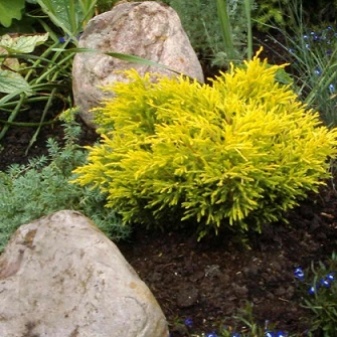
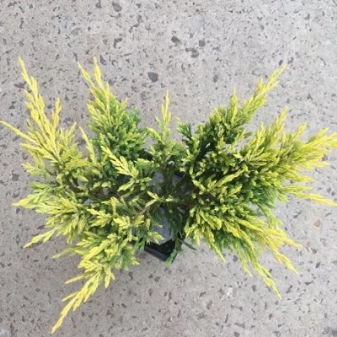
Description
The horizontal juniper of the presented variety was grown in the USA. It belongs to slow-growing species and only by the age of 15 reaches a height of 40 cm and a crown width of 2 m. The branches of the shrub grow horizontally from the middle and sag slightly at the ends. They have scaly needles and form a miniature cushion-shaped crown.
The decorativeness of the variety is not lost throughout its life; over time, the aerial part takes the form of a wide funnel. The needles also gradually change color. So, young specimens have green needles, which turn golden hues with age. In winter, the needles are covered with an orange-bronze tint. The cones are ball-shaped and black in color with a bluish tinge and light bloom.
The variety is recommended to be planted in temperate climates and in the south. A culture can live in one place for more than 400 years.
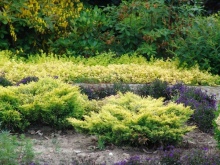
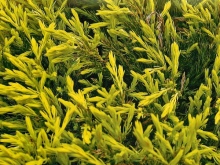
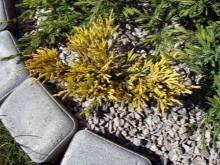
Landing
Before proceeding with planting, it is important to pay special attention to the choice of planting material. It depends on how quickly the bush will take root and how it will develop. It is better to buy a seedling in proven nurseries and consult with an experienced gardener in advance about choosing a specimen. Visually examine the selected sample: the needles should be in good condition, the color of healthy needles should be uniform.
Pay attention to the integrity of the bark on the branches, there should be no traces of disease, suspicious spots and other defects on it. The branches of a quality seedling are strong and dense. It is better to choose an instance with a closed root system - this option can be planted throughout the spring-summer period. The soil in which the specimen stands must be clean, loose, moderately moist and free from any foreign odor.


Having chosen a full-fledged planting material, it is important to choose the optimal place for planting. The variety will actively develop in a well-lit area, as it is a light-loving and heat-loving plant. A little shading is also encouraged, otherwise in the daytime the scorching sun can burn the fragile needles of a young seedling. The culture will feel more comfortable in an area protected from the wind.
The most preferred soil is loam or sandy loam, the soil should be regularly moistened and oxygenated to the roots, therefore, during the planting process, it is important to organize good drainage and supplement the soil with a nutrient mixture. Closed seedlings can be planted during the season, but the most optimal time for planting is spring.
When planting in spring, the tree will have time to get used to a new place and get stronger before the onset of cold weather.
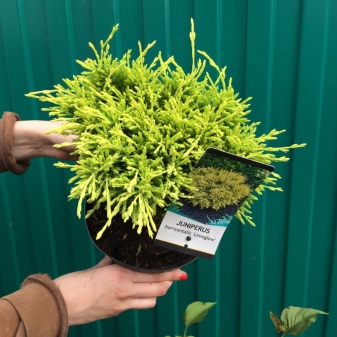
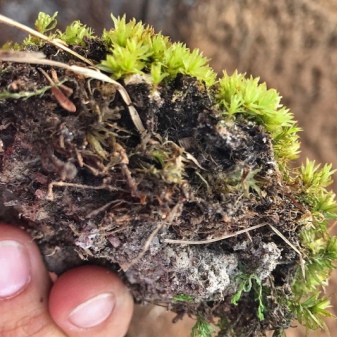
The planting process must be performed in a specific sequence.
- Dig a hole 60-70 cm deep and 2-3 times wider than the width of the rootstock of the seedling, taking into account the earthen coma.
- Place a 20 cm drainage layer of gravel, rubble, pebbles, or broken brick.
- Moisten the soil in the container that contained the plant.Remove it and process in a solution of potassium permanganate. This procedure is needed to disinfect the roots.
- Prepare a nutrient mixture. It can be done by combining sand, peat and turf soil in equal parts. Pour the finished compound onto the drainage layer and pour in 10 liters of water.
- As soon as the moisture is absorbed, plant the specimen in the hole so that the root collar is located above ground level, and dig in.
- Moisten the planting site and spread a layer of mulch made from peat, pine bark or sawdust on the tree trunk circle. Mulching will retain moisture in the soil and reduce the frequency of weeding.

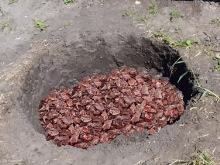
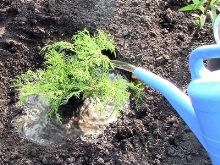
Correct care
In order for a young seedling to take root well and develop actively, it is worth providing favorable conditions for it. The basic rules for caring for a shrub are not complicated.
- Lime Glow is a drought tolerant variety, and will still be in better condition with regular watering. Moisturizing is especially important during the first time after planting. The tree reacts very well to sprinkling. In case of drought, the frequency of watering is increased.
- In order for oxygen to reach the roots, after watering, you need to loosen the soil at a level of 5 cm. The procedure is performed very carefully, since the culture has superficial roots and it is important not to injure the young roots.
- Once a season, the plant needs fertilization. In the spring, it is recommended to feed the juniper with a special complex for conifers, additional nutrition is introduced during the awakening period and before active growth. In April-May, you can feed the shrub with nitroammophos. Never use popular fertilizers such as cow dung or poultry manure - they can cause root burns.
- Sanitary pruning can be done once a season. Any broken, frozen, damaged branches should be removed in the spring. If a decorative haircut is performed, it is recommended to cut only 7 cm from the length of the shoot, otherwise the tree will be vulnerable to infection. The trimming procedure is carried out with a well-disinfected instrument, all cut sites are carefully processed.
- Young specimens need to be insulated before the onset of winter. You can protect the roots with mulch such as peat or dry foliage. The crown can be wrapped in a covering material. Adult plants do not need to be insulated, they will normally survive frosts on their own.
In winter, it is important to shake off snow piles from the branches in time - the juniper does not like gravity.


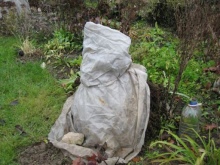
Reproduction methods
The most common and promising breeding method for this variety is cuttings. It is customary to harvest planting material in the spring. Cuttings are cut from healthy, sturdy mature shrub, along with some wood. The lower end is freed from needles. For rooting, a nutrient mixture should be prepared by mixing sand and peat in a 1: 1 ratio. This composition is poured into a pot and the cutting is planted there at an angle.
Also the variety "Lime Glow" can be propagated by layering. To do this, a good healthy shoot in the lower part is pressed to the ground and instilled. The most patient and responsible gardeners can try germinating juniper from seed. Grains are extracted from cones, dried and planted in the ground. However, it is worthwhile to prepare in advance for the fact that the first shoots will have to wait for a very long time and the potential formed plant will not retain varietal characteristics.
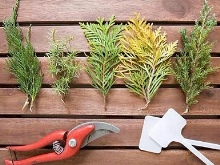
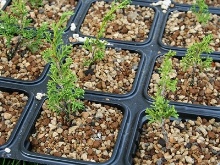
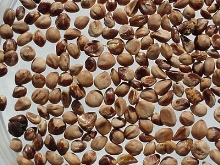
Diseases and pests
This variety has a fairly strong immunity to diseases and insects. But under unfavorable conditions of detention, this problem does not bypass the bush. For example, if the rules for watering and feeding are not followed, the plant becomes more vulnerable to ailments that cause decay. Rust and fusarium are common diseases. These are highly contagious diseases that quickly spread to neighboring plantings.Bordeaux liquid and fungicides are used to combat the problem. As a preventive measure, it is recommended to remove the needles that have flown around in a timely manner and destroy them.
Of the insects, aphids, spider mites and scale insects love the culture most of all. Individuals can be eliminated mechanically, they are visually noticeable, but this is possible only at the primary stage. When the plant is attacked by hordes of insects, chemicals will help to cope with them. For the purpose of preventive measures, systematic irrigation of juniper with a soapy water solution is allowed.
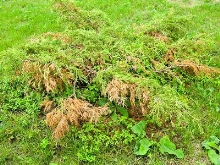

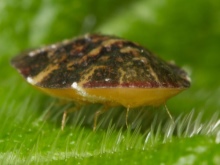
Application in landscape design
Shoots of this variety not only chaotically diverge, but at the same time, some of them can stretch upward. The result is a very graceful and elegant crown. For these features, the shrub of this variety is highly regarded by many gardeners and landscape designers. In addition to its decorative properties, the tree has phytoncidal qualities, it purifies the air, fills it with a fresh and pleasant aroma, and therefore it is used to decorate city sites and park areas.
The presented variety is very harmoniously combined when planted next to various crops. This plant does not affect the composition of the soil, which means that it can be planted near herbaceous, creeping forms, cereals or conifers. However, you need to select neighbors taking into account the preferences of both types. This variety loves good light and acidic soil, which means that the same conditions should be suitable for neighboring plants.
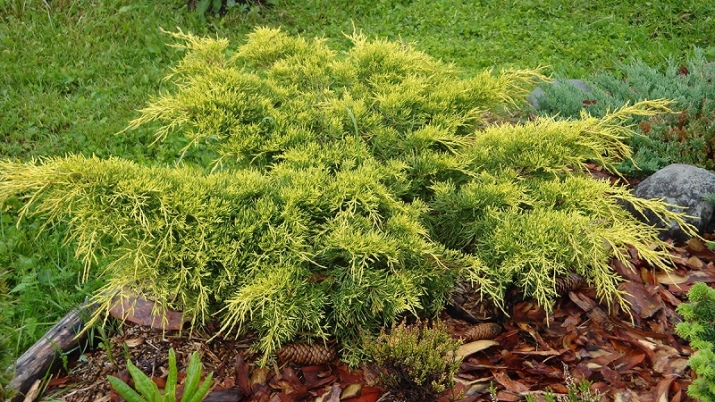
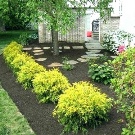
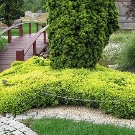
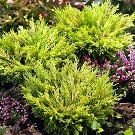
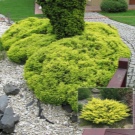

Juniper fits harmoniously when creating an alpine slide design or when decorating rocky terrain. You can frame garden alleys and borders with shrubs. A picturesque landscape is formed by combining juniper with other decorative conifers or garden flowers. It looks especially impressive among deciduous and coniferous plants of blue, green and red colors.
Looks beautiful in the garden variety "Lime Glow", if mulched with pebbles or bark. Lemon color will favorably emphasize the beauty of neighboring green spaces.
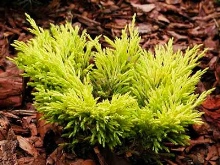
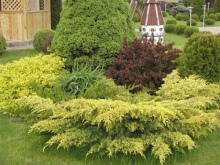
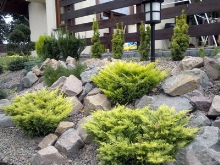
In the next video, you will find a quick overview of the Lime Glow juniper.



































































The comment was sent successfully.